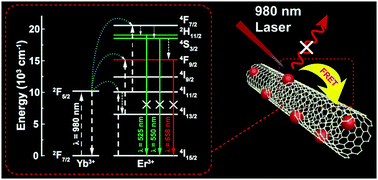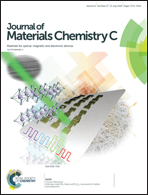Nanocomposites of carbon nanotubes and photon upconversion nanoparticles for enhanced optical limiting performance†
Abstract
Studies have proved that large nonlinearities, fast responses, and broadband spectra are pre-requisites for designing materials with good optical limiting performance. Carbon nanotubes (CNTs) have shown promising optical limiting effects with the best performance at 532 nm. However CNTs can only be dissolved in limited types of solvents, such as chloroform, dichlorobenzene, and toluene, making their general processability an actual challenge. On the other hand, photon upconversion nanoparticles (UCNPs) have strong absorption in the near infrared (NIR) region, e.g., 980 nm. Thus, in situ synthesis of nanocomposites containing UCNPs and oxidized CNTs via coordination interactions would provide both solubility in water and good optical limiting behavior in the NIR region. Experimental results have indicated that the optical limiting performance of nanocomposites is better than that of either CNTs or UCNPs, which is reasonable due to synergistic effects. Luminescence decay studies of UCNPs have suggested that Förster resonance energy transfer is responsible for the good optical limiting performance under 980 nm laser illumination.



 Please wait while we load your content...
Please wait while we load your content...